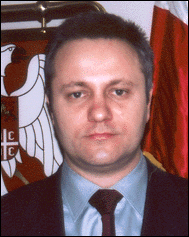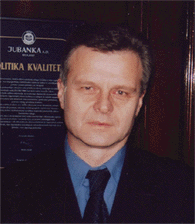 FINANCIAL SECTOR FINANCIAL SECTOR |
One of international financial institutions and foreign investors' major concerns was the highly indebted and inefficient banking system. As a response to this, the National bank of Yugoslavia shredded the number of local banks from 87 in 2000 down to 48 at the end of 2001. The four largest banks were liquidated in January 2001. The IMF stressed in late March that its strong support to Yugoslavia is, among other things, based on the excellent results the country showed in reforming the financial sector.

"Nobody in Eastern Europe has taken such radical measures as FRY, closing the four major public banks. The process of reconstructing the banking system lasted four or five years in the most successful Eastern European countries; here it will be finished in one or two years! The movements we are doing are politically and socially risky, but I think economically much more efficient", says the Governor of the National Bank of Yugoslavia (NBJ), Mr. Mladjan Dinkic.
One of the youngest Governors in European transitional countries, he is admired both by the citizens and international financial community. At October 5th, when former Yugoslav president Slobodan Milosevic was ousted, Mr. Dinkic promised that Serbia would have a strong domestic currency, sufficient foreign currency reserves, a completely reformed banking system, and an open and attractive environment for strong foreign banks.
In 1993 Mr. Dinkic, young assistant at the Belgrade based Business School, published a book, "Economy of Destruction", in which he described all the frauds of Milosevic's regime - starting from hyperinflation to pyramidal banking schemes. He knew exactly what a challenging task he will have as a central bank governor. Dinkic inherited a weak local currency and a huge shadow market in which citizens, local and foreign companies traded in DEM. After a year and a half in his post, Dinkic can proudly say that the local currency, the Dinar, is an anchor stone of stability in a still, partly fragile economic system.
The real Dinar money supply, which was only 750 million DEM in October 2001, rose up to 2,000 million DEM, at the end of 2001. The amount of foreign currency reserves of the National Bank, which was around US 360 million dollars during previous regime, went up on US 1.3 billion dollars. Plus, the commercial banks have some US 500 million dollars. Now, the dinar is covered 140% by foreign reserves, which guarantees its stability.
Furthermore, this spring the NBJ introduced partial external convertibility. The new law on foreign exchange operations, which passed in the first quarter of 2002, considerably facilitated foreign exchange transactions. Commercial banks are being given the opportunity to purchase foreign currency even outside the inter-bank foreign currency market at any exchange rate they set themselves, while the NBJ will, with its interventions, if necessary, determine the exchange rate level. The commercial banks would be able to purchase foreign currency from the NBJ at any time, not only for paying imports but also for their operating liquidity and practically for everything except capital transactions, Dinkic underlined. Even though everybody expected that Serbian citizens and companies would turn from DEM to euro, in everyday life they put confidence in local currency Dinar.
The new democratic authorities discovered a state debt of about 7.5 billion DEM (more than US 3.3 billion dollars) of citizens' frozen savings. In the pre-election campaign, the Democratic opposition of Serbia promised to repay that money and to introduce a new, sound banking system in which people may have trust. The promise has been fulfilled and citizens are going to receive regular annual installments.
The old banking system, which was comprised of 106 banks, was in huge debts, and nobody, from ordinary citizens to local companies and foreign partners believed in it. But the NBJ took strong measures to tide up the system. In 2001 it revoked licenses of more than 20 small banks and on January 3rd liquidated the above-mentioned state banks. It was probably the bravest and the most risky move Serbian reformers took since they came into power. The IMF and the World Bank prized Serbian authorities for such a move. The whole Serbian government and FRY president Kostunica backed that decision. Following that, about 8 000 of banks' former employees were given social packages and government's help for retraining.
"I think that we have completed our major tasks for 2001 and 2002. Fortunately, the first reform that will be completed in our country is the banking reform. Major things like the monetary policy and exchange rate policy are already in a very good shape and we just have to make some minor changes. From 2003, my job will become quite boring", says Mr. Dinkic.
The Deutsche Bank will open its office in Serbia ahead of plan, announced the German Minister of Economy and Technology Werner Mueller during talks with Mr. Dinkic this January. Mueller said that the Bank had taken this decision due to the significant progress and results in the banking system in Serbia. In order to revive the trust in the banking system, the NBJ created in 2001 more favorable conditions for foreign banks, which wanted to start from the green-field base. Five foreign banks took that chance: Raiffeisen Bank, Hipoverein Bank (HVB), Microfinance Bank (MFB), National Bank of Greece (NBG) and Alfa Bank from Greece.
| 
"The interest of the National Bank of Greece in this region is long term oriented and permanent. A part of our strategy is to expand our business and the first step will be opening around 15 new branches outside Belgrade on various locations within the next three years", says Mr. Athanassios Panagopoulos, General Manager of National Bank of Greece. When this branch of the bank was opened on March 2002, the whole management board of the NBG came to show its strong support. "It can be said that we have a lot of hopes for further business in this country", says Mr. Panagopoulos.
Mr. Dinkic believes that foreign banks in Serbia have the opportunity to grow very quickly, because this market is "hungry" for new products. Raiffeisen bank, which at the beginning had modest plans for Serbia, is considering to buy some of Serbian banks to expand its business. "This year, we will increase the capital base by another 25 million EUR. We have signed an agreement with the European Bank on a subordinated loan of 10 million EUR, and we will get 15 million EUR from our head office, which will represent the basis for granting larger credits, since we will have a total of 35 million EUR", says the chairman of the RFB managerial board, Budimir Kostic. So far, Raiffeisen Bank has collected over 130 million EUR worth of savings from the citizens, and has thus established its position among the most successful banks in the FRY, according to the NBJ's rank-list.
Even though a strong number of local bankers and experts believed that foreign banks would be a threat to the local banking system, in reality everything turned to be different. In the last five months of 2001, banks in Serbia recorded a tremendous increase in deposits: 160 million DEM in November and an additional 60 million DEM in the first ten days of December. Surprisingly, citizens showed equal level of confidence in foreign and domestic banks.

That is also the example of Jubanka a.d. Belgrade, a dynamic local bank that managed to regain the public confidence. "We are among the first ten banks in the country, concerning savings volume. We are now planning business policy for 2002 based on the stimulation of savings, to be able to provide some future credits for our citizens", says Mr. Borisav Djokic Director General of Jubanka. Interested in strategic partnerships, he reveals that they "are negotiating for almost a year. Lots of banks are interested, but our impression is that some political and economic obstacles for investing must be removed before we can attract any capital to Serbia. That is why now we had to turn to the maximal possible optimization of our operations."
Novosadska bank (The bank of Novi Sad, capital of Vojvodina) is among the several very strong domestic banks based in Vojvodina, the economically most developed part of Serbia. Mr. Vojin Bjelica, the general director of the bank of Novi Sad manages the oldest institution in the region, established 138 years ago. Its organization network consists of 170 units, six of which are the biggest branch offices in Serbia. The bank's clients are primarily from the main industry branches in Vojvodina: agriculture industry, the oil industry, the textile industry and trade. "No bank with joint ownership is yet established here. We received already offers from many European banks and one American," says Mr. Bjelica.
It seems that 2002 will be a very dynamic year for the banking sector. The National Bank of Yugoslavia (NBJ) proposed in March a model for bank privatization with both the majority of social or state ownership. Not only banks, but efficient private companies will be able as well to take part in this privatization process. "It is my firm intention to leave to my successors a banking system and a Central Bank in which no one will be able to bear political influence on or to try to manipulate, not even theoretically. The right way to ensure the independent position of banks, which credit policy no one from the outside will be able to influence, is privatization", says Mr. Dinkic. The Deutsche bank and Italian IntesaBCI already showed interest to take part in this process. |

